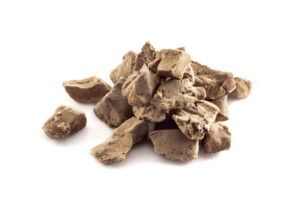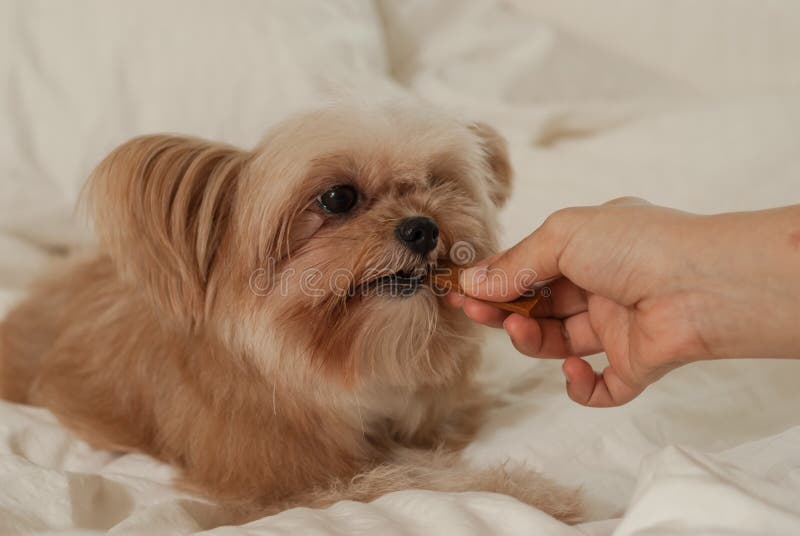LifeWithMyDogs is supported by our audience. When you purchase through one of our links, we may earn a small affiliate commission. As an Amazon Associate I earn from qualifying purchases. Your cost is not affected.
**********
Best Treats For Dog
Training with My Recipe
Many trainers perform some or all dog training with treats. Let’s face it; most dogs respond more readily to treats. But what are the best treats for dog training?
I began training dogs at the young age of 9 in the 4H program. Now, decades later, I’ve honed my skills and have my favorite tips, techniques, and treats. Over the years, I’ve used many different training treats. Some dogs respond better to one type. Others need a completely different one. And of course, some dogs just don’t train well with treats at all.
Decades ago, I discovered this little dried liver treats dogs of all types seemed to love. I first found them at a vendor’s booth at a local dog show. My dogs were hooked and so was I. At that time, I used them as bait in the junior handling ring. Success! My collie’s ears came up and stayed in position the entire time we were in the ring.
Packaged in small cartons that resembled single-serving milk containers, these treats helped me through many a dog show. However, our local pet shops didn’t carry them and they cost too much at the shows to stock up on them between. So, I went back to bits of cheese and other favorite dog treats for training between shows.
Dog Training With Treats
At that time, I didn’t use food rewards for obedience work. I reserved those for the showmanship and breed rings and training for those disciplines. One day I decided to try treats to gain my dog’s focus on the recall. Wow! I was instantly impressed with her reaction.
I then tried using them with other dogs and found similar success with most of them. One dog was not impressed with the liver treats. But he was definitely not food motivated, so understandable.
Over the years, I’ve discovered a few dogs found food too enticing. Dog training with treats definitely was not possible with them. In fact, having treats in my pocket created more distraction than these food-cravers needed. In fact, the smell of my pocket, now empty of treats, proved too much of a distraction.
Enter the Bait Pouch
Not only do treats crumble and smear in your pocket. They also leave an aromatic smell that some dogs work with. I’ve seen obedience competitors use this to their seeming advantage in the ring at shows. They keep treats in their pocket and remove them just before entering the ring. However, this causes problems for some dogs. That treat aroma grabs their attention faster than the handler cues do.
A bait pouch settles the problem for these dogs. I carry bait for dogs that work with it. But then I remove the pouch when working with the bait-craving dogs. The tempting smell goes with the pouch. Problem solved!
Bait Pouches come in various styles. Some have extras attached. They might attach around your waist, use a belt clip, or over your shoulder or neck. I like this one as it offers versatility and holds enough treats for my training sessions.
Best Treats for Dog Training
I’ve used many types of treats for training. While some people prefer things like hot dogs, I’ve never liked them. Maybe it’s because I don’t eat them, myself. I have used mozzarella cheese sticks quite successfully. Before starting, I just cut the stick into many pieces. Place it into the bait pouch and off we go.
Similarly, I’ve found that some cat treats work well for dog training with treats. Some are crunchy, but my smaller dogs seemed to prefer the soft and moist variety. These treats come in a very small size which works well with the toy and small dogs. However, even my larger trainees seem to like them. The ones I use come in a small packet that fits into most bait pouches or even some pockets. This makes clean up easy!
Healthy Liver Treats Dogs Love
I still use cat treats and cheese for some dogs. However, my favorite “go-to” treat remains the dried liver treats dogs can’t seem to resist. In fact, I use these around the house and at bedtime, too.
For these, you have choices. My dogs seem to prefer the beef liver flavor of the ones I purchase. I keep a supply of the larger containers on hand. Since we have a multi-dog household, this works well for us. In fact, these dehydrated treats last a very long time in dry storage. Therefore, keeping extras just makes sense.
Your local pet store may carry these. If not, you’ll find them available at Amazon (see link below).
These liver treats are actually freeze-dried, rather than dehydrated. However, the resulting product is similar. I use them interchangeably.
Although this product costs a bit, please note the ingredient list. Yes, it is just liver. No wheat flour, corn fillers, sugars, or salts. And no preservatives. They aren’t needed. So while the cost seems high, I believe the quality makes it worth the cost.
Dried Liver Dog Treats Recipe
 Yes, I promised a simple way to save money using our dried liver dog treats recipe. Because I choose not to use fillers and additives, this works best for our home. Admittedly, we keep the product listed above on hand. But when we do make our own, the savings is quite noticeable.
Yes, I promised a simple way to save money using our dried liver dog treats recipe. Because I choose not to use fillers and additives, this works best for our home. Admittedly, we keep the product listed above on hand. But when we do make our own, the savings is quite noticeable.
If you have ever made jerky, you already know how to make these. Our dried liver dog treats recipe essentially mimics jerky.
This works for any type of liver. However, most people start with either beef or chicken.
Follow these steps:
1. Preparation
On a clean cutting mat, cut the liver into strips. I prefer about 1/2″ wide, but decide what works best for you. It will shrink as it dehydrates, so compensate for the shrinkage. Expect to lose about 1/2 to 2/3 of a pound once dehydrated. So, if you start with 1 pound of liver, you should have 1/3 to 1/2 pound final dehydrated weight.
However, those estimates use beef and poultry portions. Fish and some wild game differ in the amount of water content. I suggest you weigh the product before dehydrating it.
2. Dehydrating
Put in your dehydrator for the recommended time. In most cases, this step takes about 3-5 hours. It depends on the size of the pieces and the power of your dehydrator. Of course, the water content factors in, as well.
No dehydrator? Use your oven! Yes, your oven works as a dehydrator when set on a low setting. For this method, set your oven to about 170°F to 200°F. Place the liver strips on a baking sheet lined with parchment paper. For a softer product, leave in about 3-5 hours. For a crisper treat, leave it a little longer. The crispness depends on the thickness of the liver, the width of treats, and humidity level.
Want them even drier and crisper? Allow them to cool completely in the oven (turned off) with the door slightly opened.
3. That’s it!
Yes, you made your own homemade treats with our dried liver dog treats recipe.
Store these in an airtight container. I’ve never had them go stale, but then, I “treat” my dogs well!
In Summary
I like to use liver treats for training my dogs. In my next post, I’ll give information on how I use these treats. It varies according to what we are training for and the individual dog. Subscribe so you don’t miss upcoming information!
Also, upcoming articles will include reviews and information on dog treats, chews, and other products that I have personally given to my own dogs. We’ll be discussing why some are good for certain dogs, but not for others. Also, I’ll be adding in various training tips and techniques in an effort to help you form a tighter bond with your own canine companion!
Read More
Foods That Dogs Need to Avoid Eating
9 Best Puppy Training Tips: Raise a Good Pup!
Allergic to Dogs: Symptoms and Treatment
Dog Agility At Home, Top Tips for Fun Training
Service Dog vs Emotional Support Dog
Why do Dogs End Up in Shelters? Top 10 Reasons
9 Best Puppy Training Tips: Raise a Good Pup!
Do Dogs Benefit Humans? In What Ways?
Liver Nutrition Facts (HealthLine)




